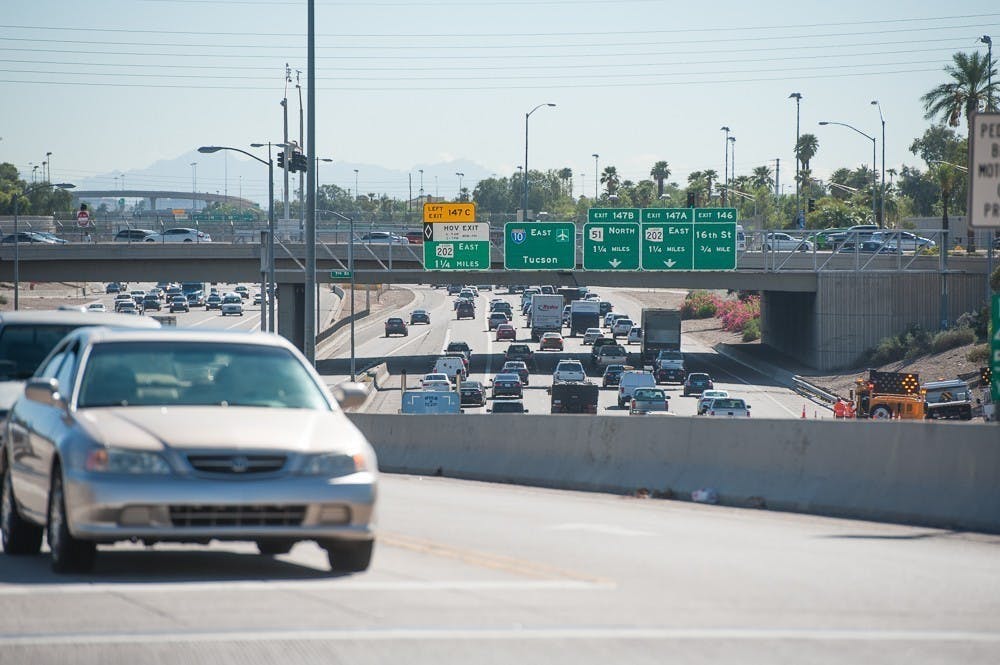Several ASU faculty and researchers gathered in Houston, Texas from Jan 10-12 for the third 10 Across Initiative Summit to discuss the future of the Interstate Highway 10 (I-10) corridor in regards to city expansion in the face of social, economic and climate change.
Wellington "Duke" Reiter, special advisor to ASU President Michael Crow, started the 10 Across Initiative, which aims to bring together the top leaders in the fields of water, energy and infrastructure in order to address some of the most pressing issues facing cities along the I-10.
Reiter has a background in the field of sustainable urbanism and was instrumental in the expansion of ASU into downtown Phoenix and Los Angeles. He has also helped several other state universities expand into city centers with the University City Exchange.
READ MORE: ASU's expansion into California seen as rare step for a public state university
The I-10 corridor, or the 10 Across region, stretches from Los Angeles to Jacksonville, Florida and runs through both Tempe and Phoenix. Reiter says the problems that I-10 cities face offer a window into the future of national development and democracy.
This corridor also includes some of the fastest growing metro areas in the U.S. According to the U.S. Census Bureau, Queen Creek and Buckeye were among the 15 fastest-growing cities or towns in the U.S between 2020 and 2021.
"We are well aware that the 10 Across geography is on the front lines of economic, social, demographic and climate change. That's why we picked this geography. There's no other connective tissue that has this," Reiter said.
Houston was the host city for the 2023 10 Across Summit because it is one of the leading cities for energy capital in the U.S. The transition to clean energy is essential to the future of the country, and states are losing out on large investments for hesitating to move away from fossil fuel-based energy according to Reiter.
"Not only are potentially forward thinking companies impacted because their customers are asking for them to make investments that involve the environment, good governance and other things like that," Reiter said. "But citizens of Texas are losing out on hundreds of millions of dollars because they're not investing in some of these things."
Within the 10 Across Initiative, water has been a cornerstone of the summit since its inception, according to Reiter. He lived in New Orleans for many years before moving to the Valley nearly two decades ago. During his time in New Orleans and his time in the desert southwest, he became aware of the distinct challenges that each region faced, whether it be too much or too little water.
Specifically, in the desert southwest, droughts have ravaged states like Arizona and California. Data from the U.S. Drought Monitor shows that as of Jan. 17, over 50% of Arizona was classified as being in some level of drought.
READ MORE: One Billion Gallons: ASU and the Future of the Colorado River
"We used water as the primary schematic for the first few summits because it's just so stark; this equation of too much and too little and the extremes of that are in this part of the country," Reiter said. "We started with water, because it's measurable, everybody understands it."
ASU's own Rhett Larson and Susan Craig were a part of the Seeing Water Clearly workshop at the 10 Across summit. Larson is a fellow with the Kyl Center for Water Policy at the University's Morrison Institute for Public Policy researching and teaching in fields such as property and water law. Craig is helping in the University’s New Water Innovation Initiative, a $40 million investment into the University to continue working with partners on water conservation efforts.
Craig worked on the Arizona Water Blueprint, an all encompassing tool used to explore data on Arizona's water resources and the Colorado River.
"I was able to showcase the The Arizona Water Blueprint," Craig said. "Specifically the signature map piece of the blueprint along with some other tools and then also the newly launched CuRVE project, which is the Colorado River visualization enterprise tool, and specifically focused on the impacts of the Colorado River shortage," Craig said.
Larson said that he appreciated the opportunity to share proposed solutions, such as the possibility of creating a pipeline to deliver water from the Gulf region to the West coast, and the ability to disseminate information on water resiliency.
"On water data, I think we opened up some promising opportunities for sharing information and collaborating amongst different communities that are taking different approaches to trying to make water data more available and more transparent, more accessible," Larson said.
Reiter said that the future of democracy, economically and politically, is going to play out in the I-10 corridor.
"For an understanding of the future of democracy in the U.S., this corridor is hugely important, and we want to engage in those topics. We want to hear different opinions," Reiter said.
Clarification: A previous version of this story said Craig's role in the University's New Water Innovation Initiative was a leader. She is only helping in the project. The story was updated on Jan. 23, 2023, at 6:05 p.m.
Edited by Shane Brennan, Reagan Priest and Anusha Natarajan.
Reach the reporter at greygartin@gmail.com and follow @greygartin on Twitter.
Like The State Press on Facebook and follow @statepress on Twitter.




